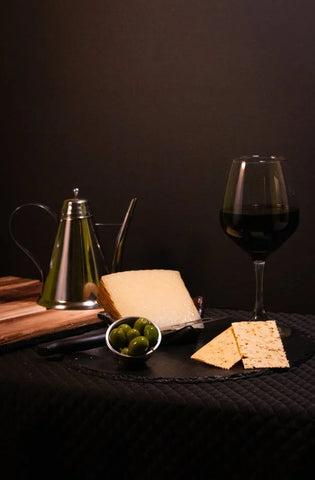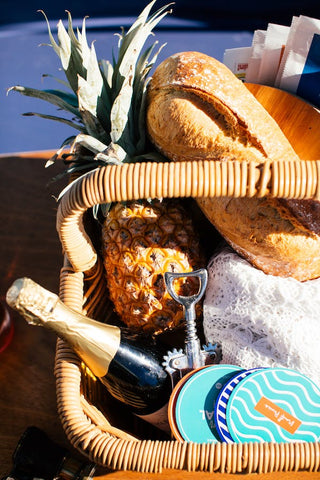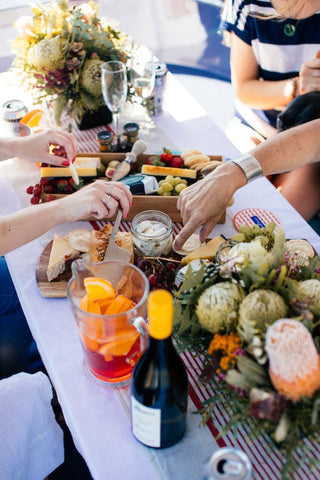
Why is Pairing Food and Wines Important?

The main objective of food and wine pairing is to improve people’s dining experience, and this is greatly influenced by choosing a good wine that can heighten the flavours, textures, and features of the food, and this gives you and your guests the assurance that your wine and food selections are paired well together.[2] Meanwhile, a poor wine match can ruin the flavour of the wine and make meals less enjoyable as a whole. Just keep in mind that wine should never replace or dominate food.
On the other hand, there are still several reasons why people plan out their food and wine combinations for any specific event, such as the following:
1. Quality - You wouldn't pair a $200 steak with a root beer or a Taco Bell with a 1947 Cheval Blanc because, obviously, they wouldn't taste right for your guests. If you are throwing an event, you want your wine to be of equal quality to your cuisine.2. Region - A wine native to the region or country where the meal is from is commonly the ideal wine to pair with it. For instance, duck and quail are common game birds consumed in France, and they pair well with Pinot Noir, while in Australia, you'd often observe wine connoisseurs enjoying a glass of Shiraz or Cabernet Sauvignon with beef and mushroom or steak.
3. Taste and Smell - Some drinks and foods simply pair better. There are qualities of aroma that work well together because wine isn't only about the flavour; it also has a distinct scent that enhances the tasting experience.
4. Weight - The weight of the wine and the dish should be equal. You should only eat a little heavy cuisine and drink mild wine. It will feel mismatched; similarly, a glass of rich, black wine should not be paired with a light, airy dish. For this factor, the texture should also be considered as well.
5. Personal Preference - Wine tasting is primarily a matter of personal preference, as many wine experts will tell you, and they're right. The world's best salmon won't make you enjoy Gewürztraminers if you don't already, which is why at some point, we can't take into consideration everyone's individual preferences when we host our wine dinners.
Terms To Keep in Mind (Wine Pairing)

Now that you know why wine and food pairing is essential, there are still several crucial terminologies to keep in mind as you move forward in this article:
- Acidity: All grapes have acidity, which aids in the wine's preservation. Acidity levels will be higher in wines with a sharper, crisper flavour.
- Body: A term used to define a wine's flavour characteristics. For instance, a wine with a strong taste and a long aftertaste is said to be full-bodied.
- Dry: Dry wine is one that often contains little or no sugars.
- Tannin: Tannin is a chemical substance found in grapes' skin, seeds, and stems. Some are used in the wood barrels' ageing process.
Planning Your Food and Wine Pairing

If you’re sure about planning out your next occasion, then follow these simple steps in pairing your dishes and wines for your guests:
Step 1: Identifying Basic Taste Components for Food and Wines

Before knowing how to pair food and wine, it's essential to note that each of them has its own distinct taste and flavour. Today, we know that there are more than 20 different tastes in food, ranging from the basics like sweet, sour, and fat to the extremes like hot, umami, and electric. Fortunately, when matching food and wine, you only need to pay attention to the following six tastes: salt, acid, sweet, bitter, fat, and spice (Piquant).
In identifying a food's basic component, it's best to reduce the meal to its essential, prominent flavours. For instance, the two main ingredients in baked macaroni are salt and fat. A little more complex is the southern barbecue that combines fat, salt, sweetness, and spice (with a hint of acid). Even vegetarian foods can be made simpler. For example, creamed corn gives fatness and sweetness, while a green salad offers acidity and bitterness.
While fatness, spice, and saltiness are often absent from wine, it occasionally contains acidity, sweetness, and bitterness in various amounts. In general, there are three categories into which you can divide wines:
- Bitterness - Red Wine
- Acidity - White, Rosé and Sparkling Wine
- Sweetness - Sweet Wines
- Considering the Food and Wine’s Intensities
Step 2: Considering the Food and Wine’s Intensities

When it comes to determining their intensities, you need to remember to ask yourself these questions once you’ve identified the food and wine’s basic taste components:
For Food: Is the food extremely rich or extremely light? A salad may seem lighter but could have a high-acid balsamic vinaigrette dressing. Just concentrate on the intensity of each taste component if the dish's strength isn't immediately evident (acidity, fat, sweetness, etc.).
For Wine: Do you prefer bold or light wine? Some examples are:
- Cabernet Sauvignon has higher tannin and a fuller body (more bitterness)
- Chardonnay is generally less acidic and has more body
- Pinot Noir has a lighter body (for red wine) and less tannin than other varietals (bitterness).
- Sauvignon Blanc is a light-bodied wine, but its acidity is higher.
Step 3: Choosing Your Pairing Method

After identifying the taste components and their intensities, you may choose which pairing method you prefer to make the most out of your dining experience[3].
The selected food and wine will have various tastes or chemical components in common. A sweet wine may be matched with a portion of sweet food, whereas a buttery pasta dish may be served with a red wine with a buttery aftertaste. You just need to ensure that the flavours of the food do not overpower the wine because it is crucial when developing balanced combinations. When this happens, the wine's flavour may become uninteresting.
Congruent pairings can bring each other's flavours into the meal and wine. When attempting to establish congruent pairings, red wines are an excellent choice. Red wines are incredibly diverse and straightforward to pair with similar food pairings, with flavours and aromas ranging from cherry to smokey. It makes sense to match some of your favourite grilled meats with a glass of full-bodied Syrah wine because they have a similar flavour profile.
Contrarily, complimentary pairings focus on combinations of food and wine that don't share any components or flavours but rather enhance one another. Their conflicting qualities serve to balance the flavours of each.
White, sparkling, and rosé wines are all great options for contrasting meals. When served with a hot dish, a sweet white wine will allow the wine's sugar to chill and counteract the heat.
White wine with salty foods is another typical complementing match. The wine's sweetness is reduced by the saltiness of the meal, which also enhances the fruity flavours and aromas of the wine. Salty popcorn and fried foods go incredibly well with a drink of Chardonnay or Pinot Grigio.
Step 4: Balancing the Food and Wines Flavors

Once you’ve chosen your preferred pairing, you can determine the food’s flavour balancing that suits well with your dish.[4]
- Acid - Acidity is a common ingredient in food and wine, allowing for complementary and compatible pairings. Acidity can give food and wine a more fresh flavour. The acidity of the wine and the food should be at least equivalent when pairing, or else the wine would taste flat. The general rule is that your wine should be more acidic than your meal. Since salad dressings have a high acid content, it's necessary to base salad pairings on the dressing rather than the salad's ingredients. Sauvignon Blanc pairs well with acidic sauces.
- Bitter - There is one important rule to remember when eating bitter foods and drinking bitter wine. Do not combine bitter foods and wines; avoid congruent combinations at all costs. The harshness in the meal and the wine will only be increased by pairing with them, resulting in a bad pairing experience. One recommendation is to experiment with more complementary pairings, such as acidic wines, off-dry Riesling, and Zinfandels.
- Fat - One of the few flavour qualities absent from wine is fat. Because of this, the secret to matching fatty cuisine and wine is to make complementary pairings. Tannins are a crucial component of wine that complement rich foods. Bitter wine tannins can enhance flavours by softening meat's fat. A cabernet-based wine is an excellent recommendation. This is true because the wine's fruit and berry notes will go well with the meat's smokey tastes.
- Salt - Many different foods include salt, including fried foods, pasta sauce, and potatoes. Foods high in salt can significantly alter a wine's flavour profile. As a result, acidic and effervescent wines match salty dishes. Acidic wines provide a fantastic complementing match and can help a dish's flavours balance.
- Spice - Although complicated, spicy foods allow for both complementary and congruent pairings. The primary factors to keep in mind are spicy foods' potential to boost the bitterness and acidity of a wine's flavour while lowering its body and sweetness. With a touch of sweetness and wonderful fruit flavours, Riesling and sparkling wines are fantastic complementing matches.
- Sweet - When combining wine with desserts and other sweet foods, it's essential to consider the sweetness level. If the wine is not sweeter than the dessert, it will be overpowered and eventually lose its flavour. Wine's bitterness can be enhanced by sweet foods, making the flavour unpleasant to most people. So, stay away from drinking tannin-heavy wines with sweet foods.
Step 5: Start Enjoying Your Food and Wine Pairings!

Once you’ve done all these steps, you may taste your combined food and wine for a great dining experience. On the other hand, remember that wine and food pairing is subjective. Yes, there are some essential criteria for pairing wine and food, but these are not universal standards. Instead, follow your own preferences, and you won't go wrong. While you’re at it, start shopping here at Kendricks Familia Imports for some wine you can pair with your dishes for your next special occasion!

